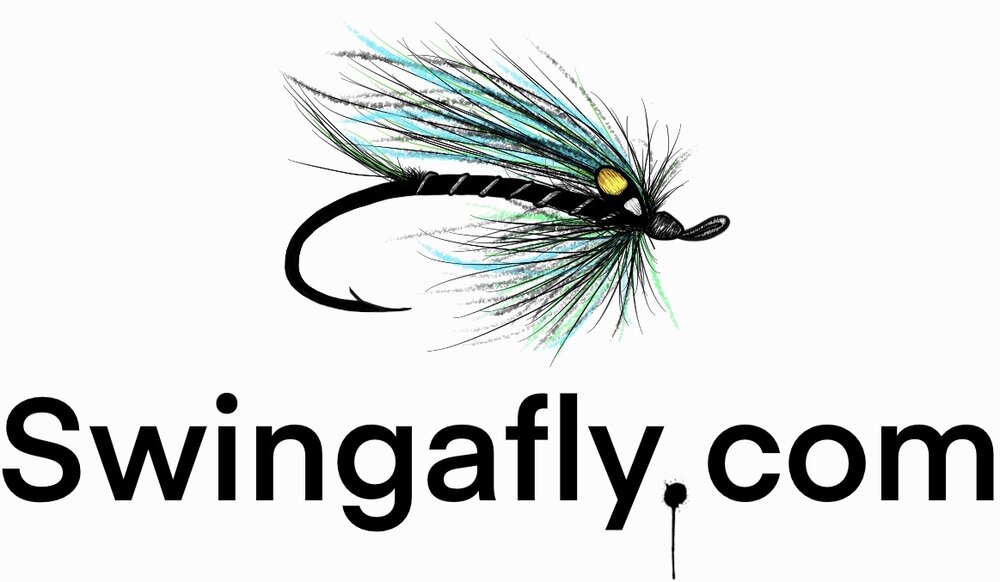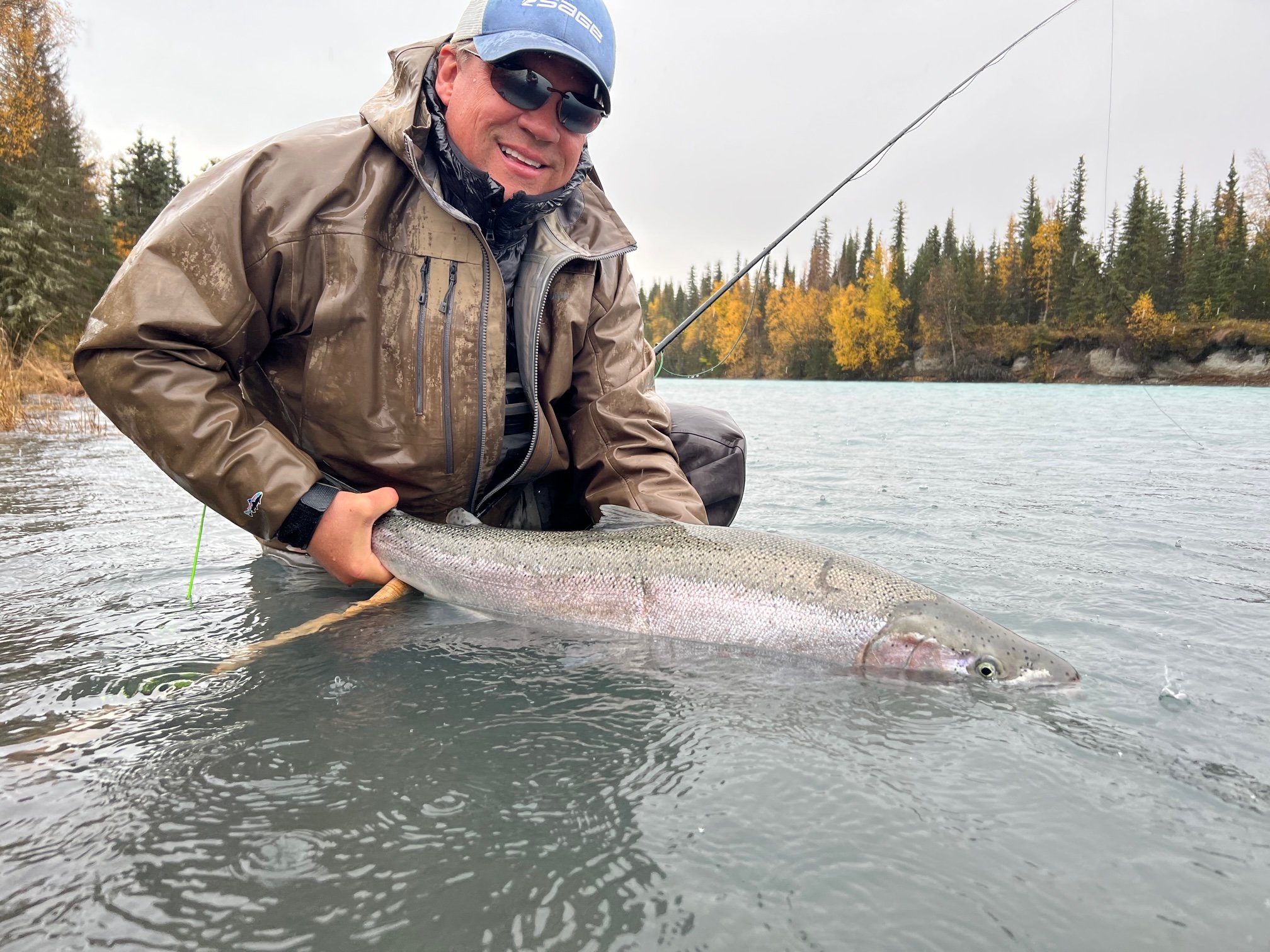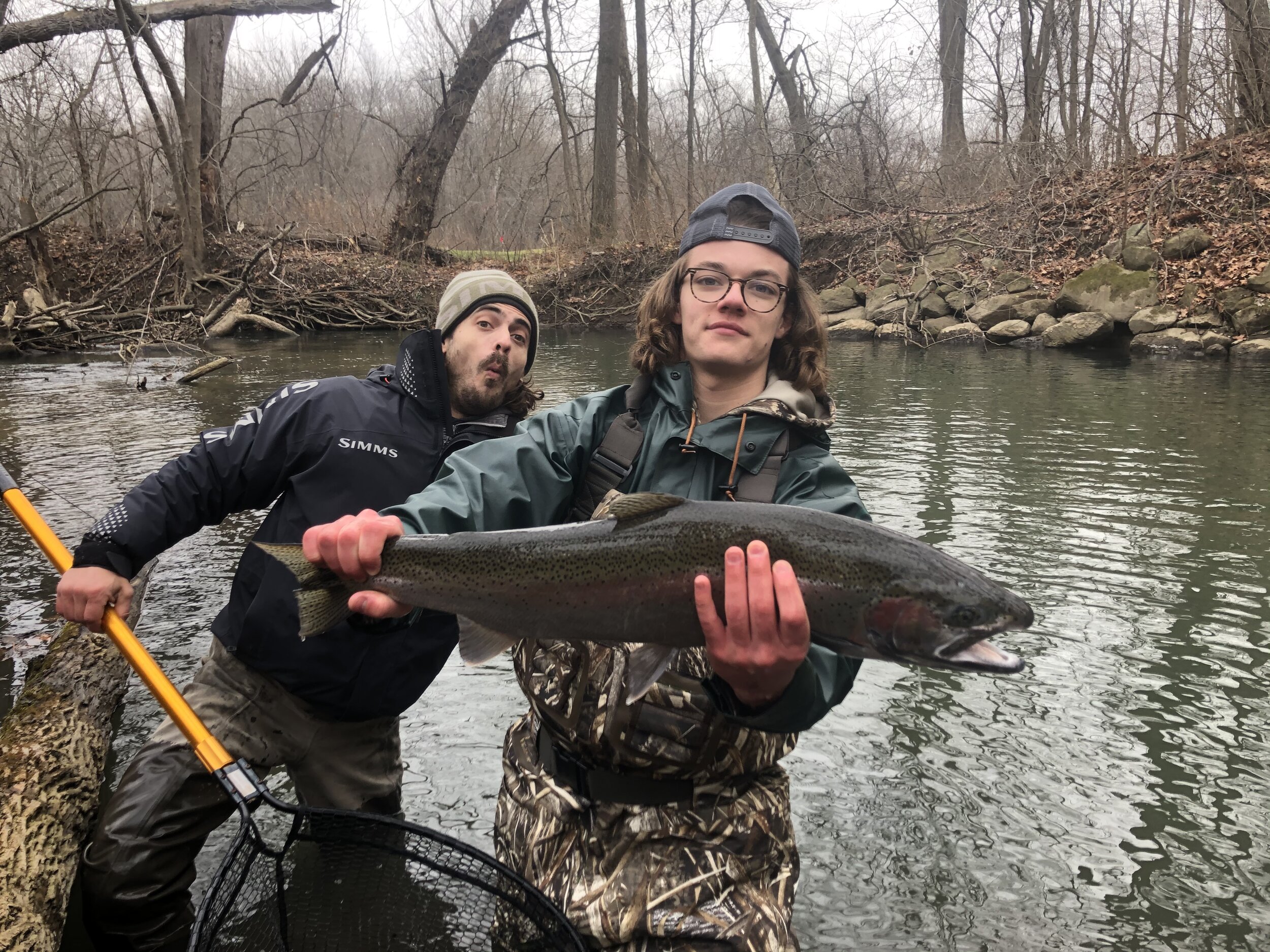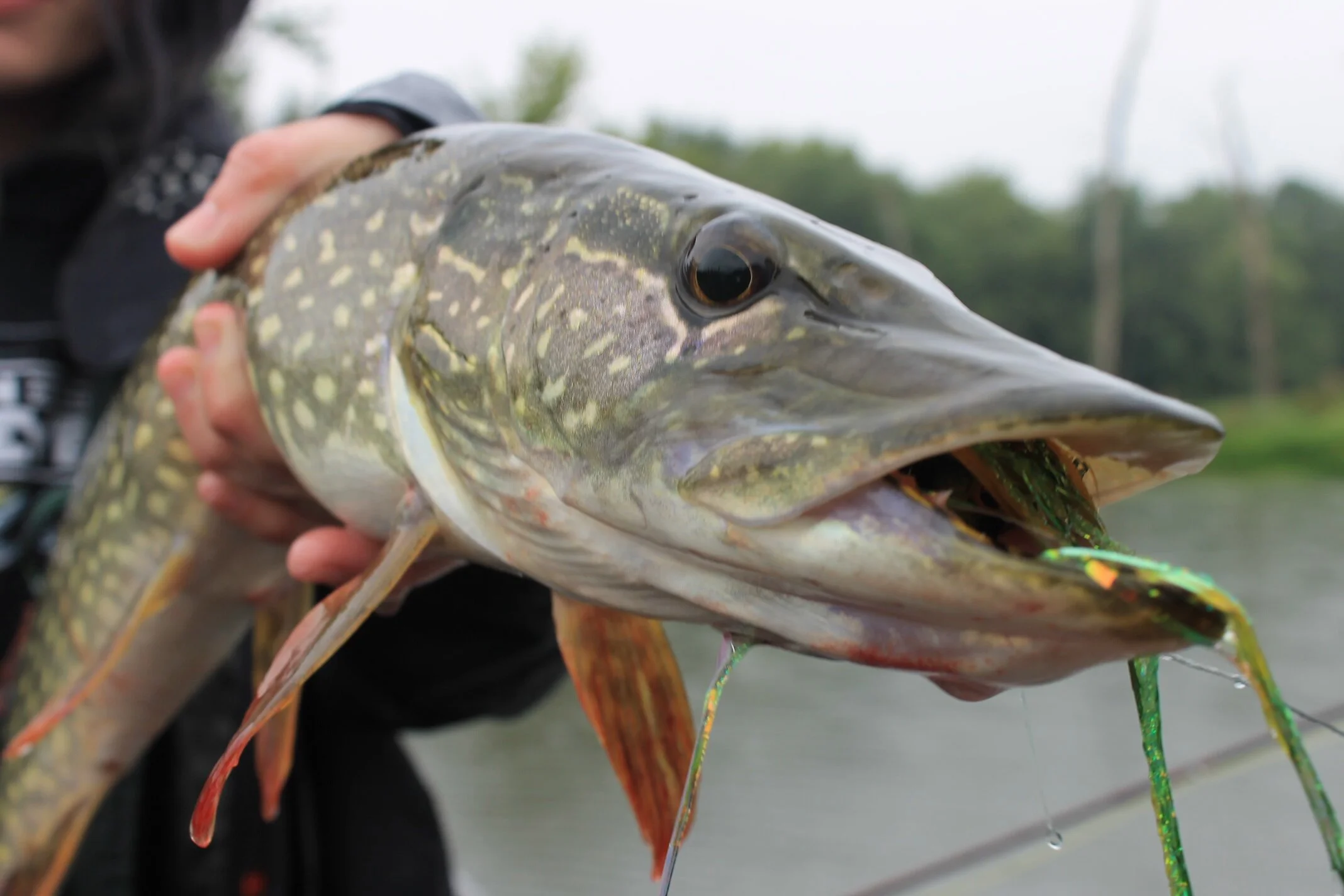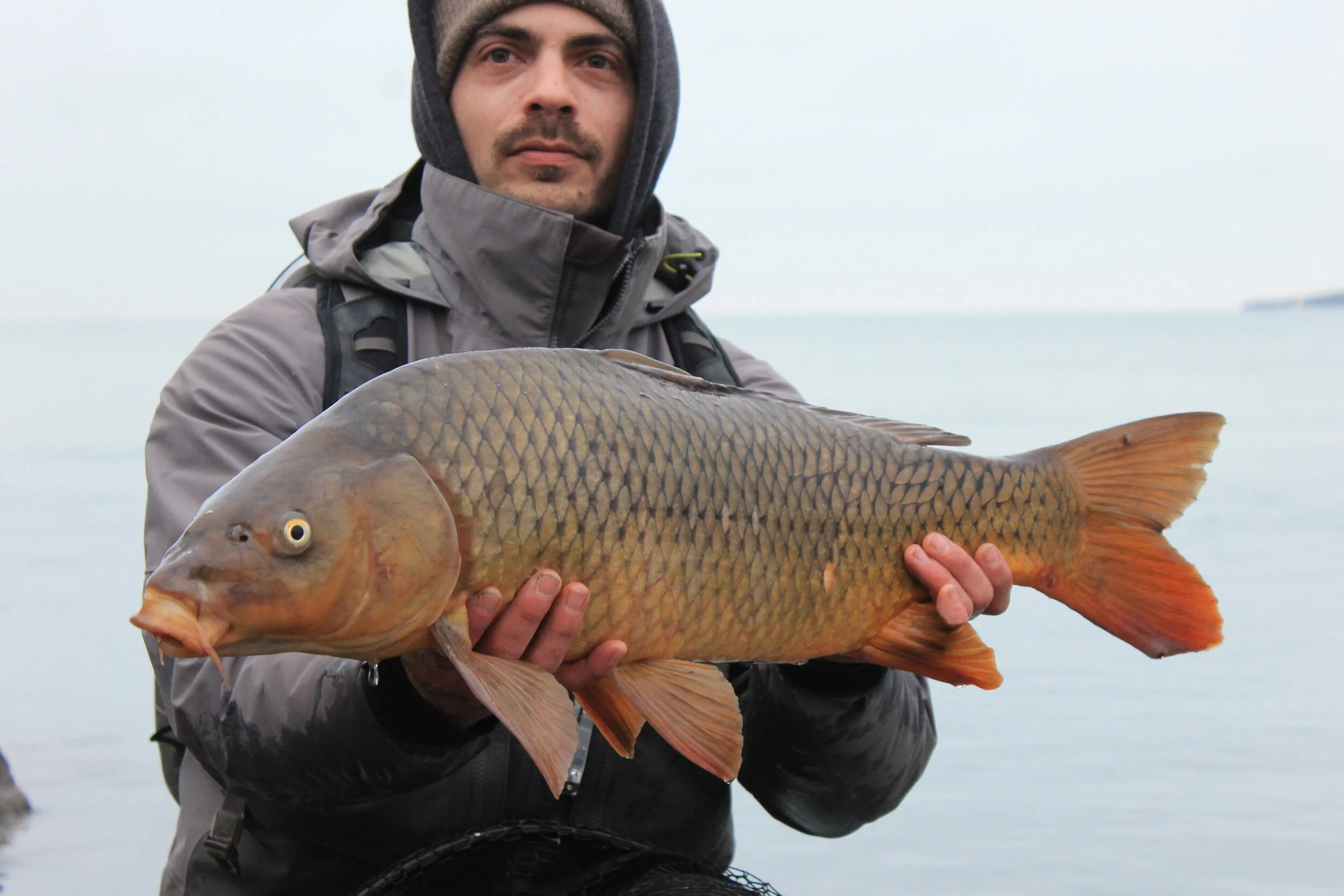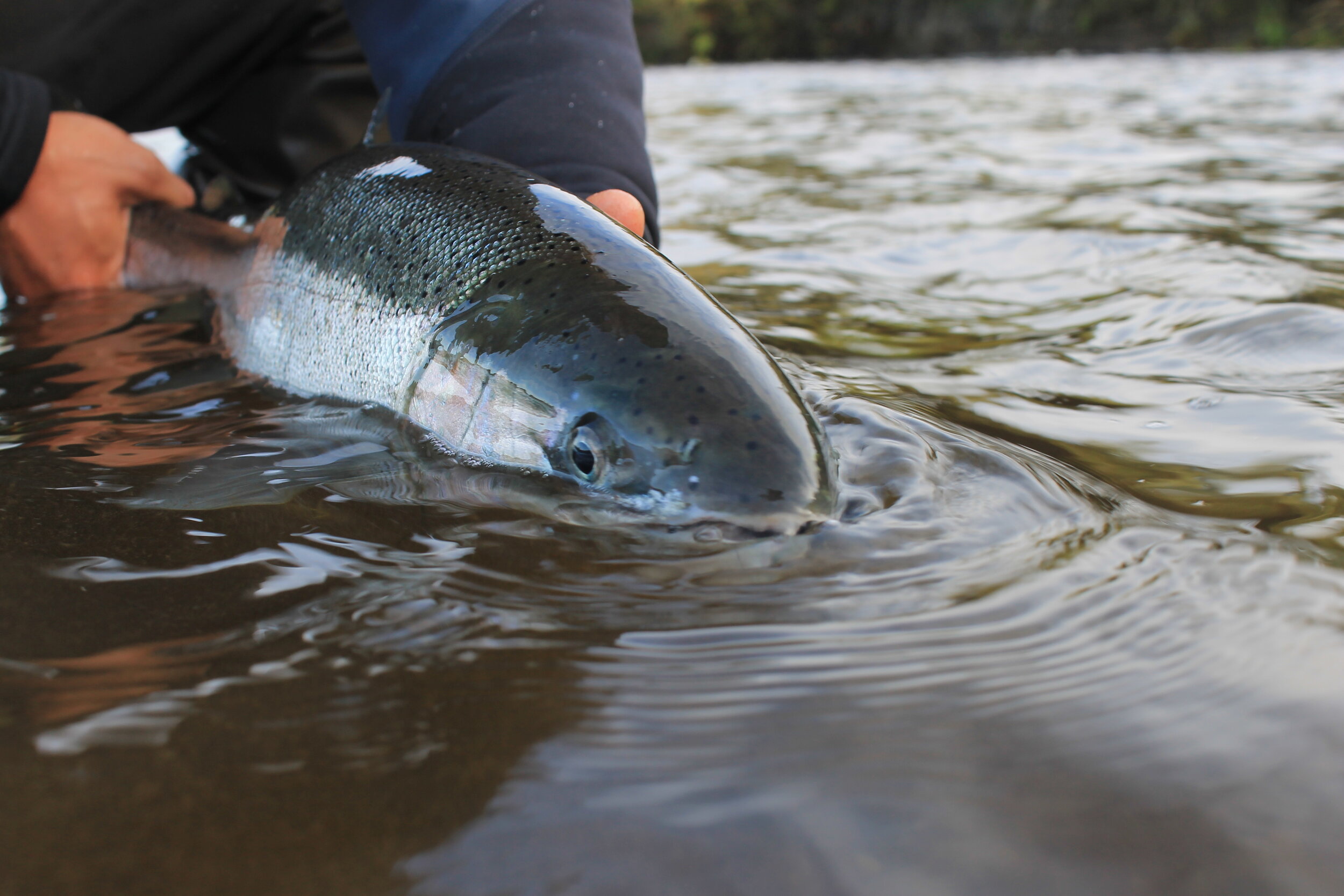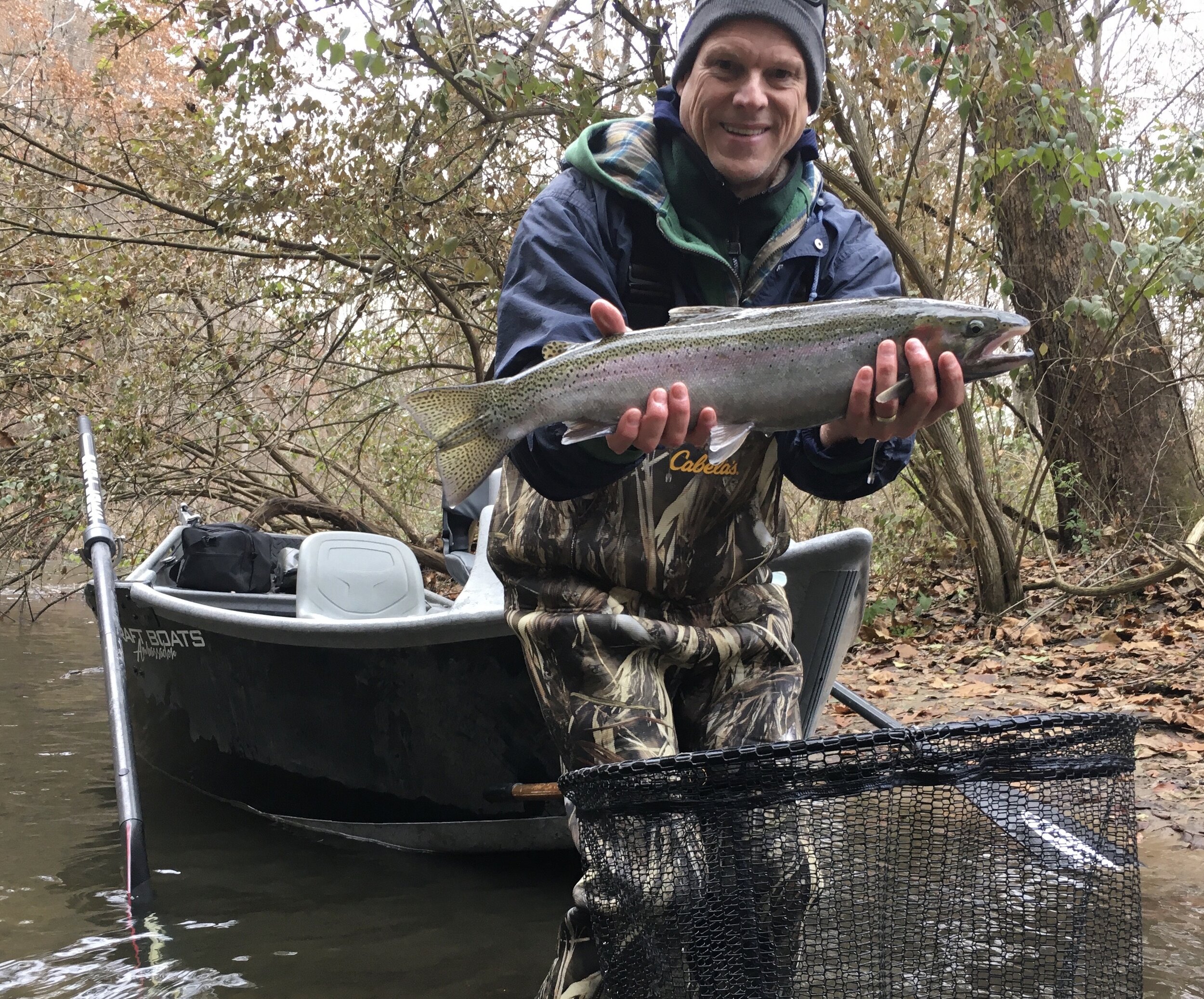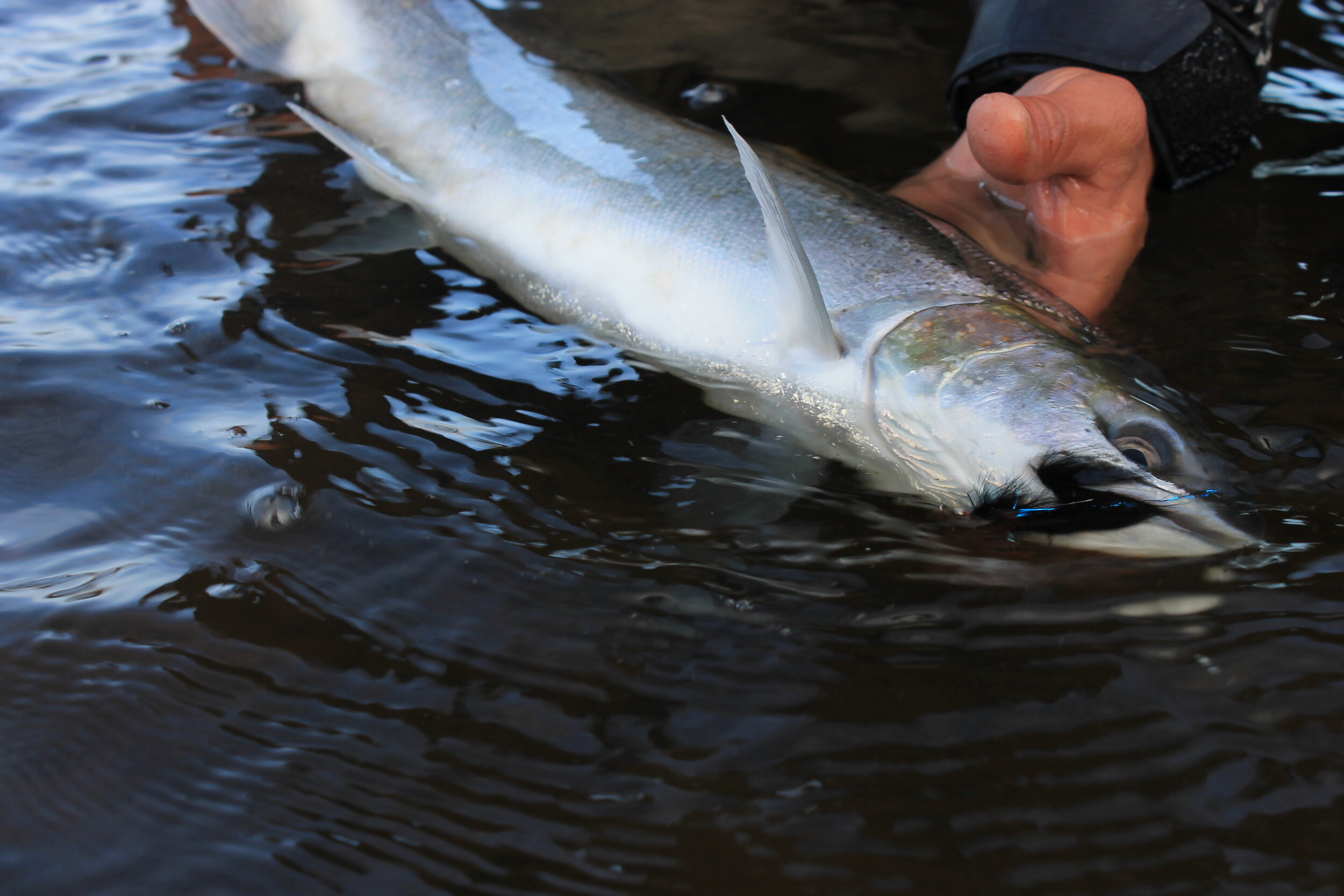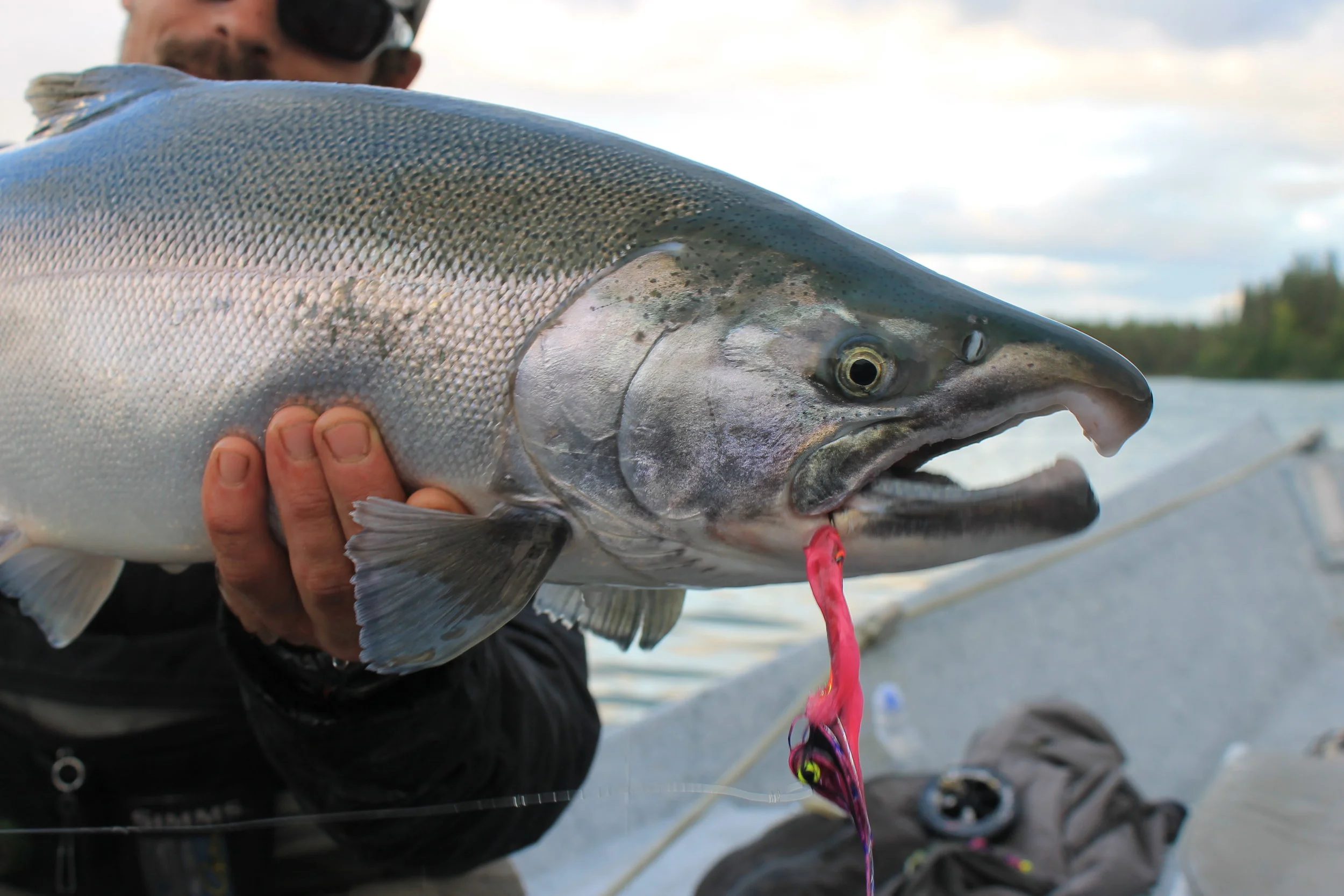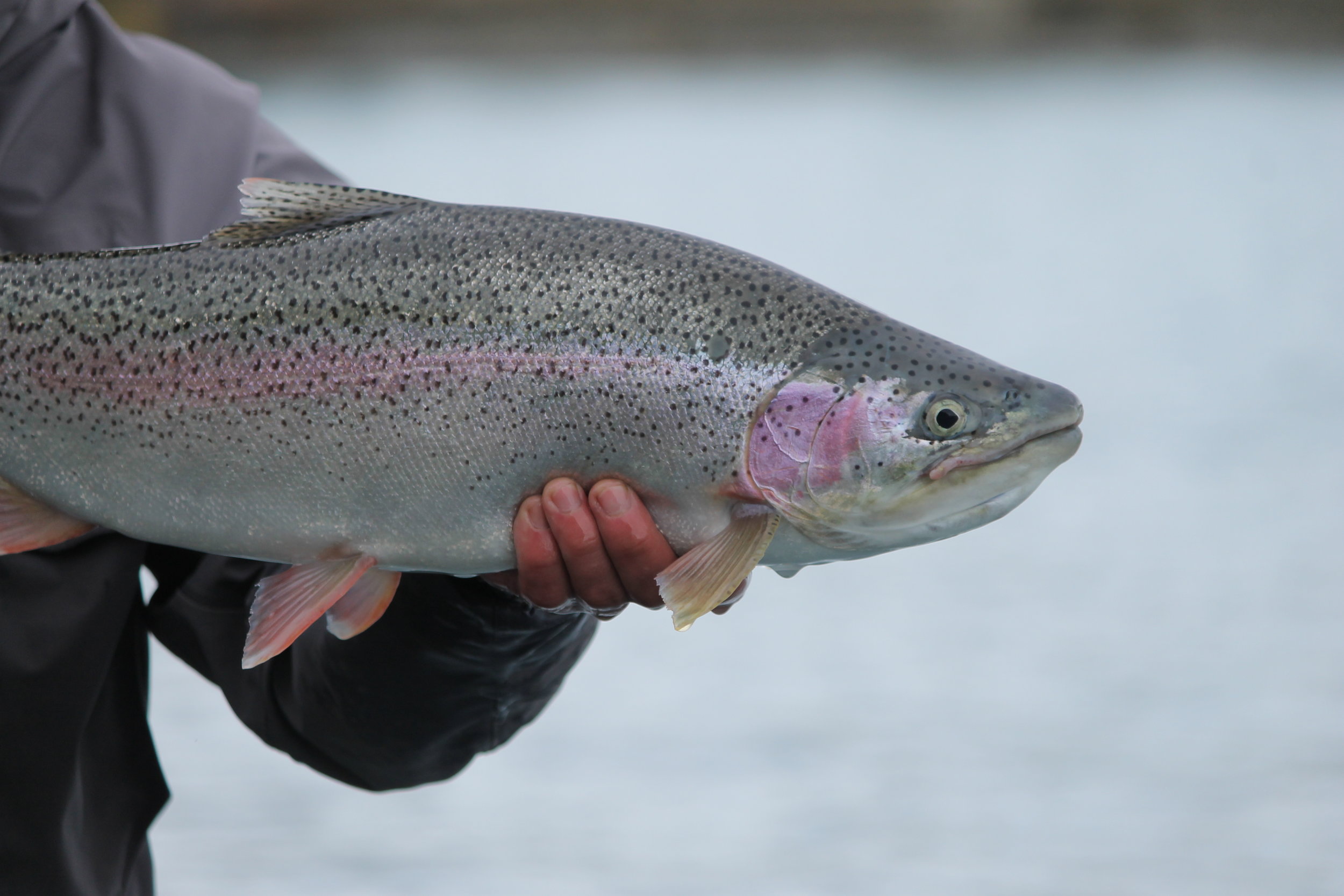Although the Kenai doesn’t get a run of chum salmon, some smaller neighboring rivers do. On a rare day off, I like to take a drive to do some fishing for myself. This day back in 2018 was a success!
Ambitious eagle attacks trout
Gotta keep your head on a swivel up here
Steelhead
Part V and the final part of recycling website material for the blog we are going to chat a bit about fishing for steelhead on the peninsula.
Steelhead are considered the gentleman’s fish. A fish of a thousands casts, these fish boast big time power and athletic ability. A true sportfish. Typically not a trip for the casual angler. Expectations are never high on a steelhead trip and some folks are not okay with that. Run timing is everything. Each year can be a bit different. If timed right, the steelhead fishing on the peninsula can be incredible. Typically, we start to take clients on the upper Kasilof river for steelhead right around the first week of September. The run gets stronger as the month goes on but catching it early can be pretty amazing. These trips are fly fishing only and we practice catch and release with all wild steelhead. We cater to both spey fishing or indicator fishing. Both techniques work very well. The upper Kasilof is a very peaceful and beautiful float. I would describe the river as very pleasurable to fish. Easy wading, gorgeous runs to swing. The fish can be anywhere from 5 to 20 pounds and larger. With the Kasilof river being the shorter of the two rivers, these fish stay pretty hot and energetic throughout the system. Nothing like a big broad side smash from a sea-liced steelhead! The Kasilof is big enough for a full length spey rod and fits best with a 10’ 7wt if you are bead fishing. There are some smaller streams to walk/wade for steelhead around the peninsula where a single hand spey would be appropriate as well. Temps can tend to drop during steelhead season so bringing the proper layers is crucial for your visit. All of the fishing will be out of the boat so its best to come prepared with plenty of warm gear for this trip. Are you tough enough to take on some Alaskan steelhead. Feel free to give us a shout and we would love to help you find out!
Rainbow trout and dolly varden
Part IV of recycling my website material for the blog, we are talking about rainbow trout and dolly varden here on the kenai peninsula.
Alaska has some of the largest rainbow trout in the world. Largely due to their diet, the rainbows and dolly varden feast on salmon flesh and eggs and grow to enormous size and length. Alaska’s trout fishery is unlike any other trout fishery in the world. Something any trout angler needs to experience at least once in their lifetime. The Kenai is where we do the majority of our trout fishing. It’s cold glacial water provides excellent habitat for these fish. The dolly varden in the Kenai are both resident and sea run. Whereas our rainbow trout are all resident with some steelhead mixed in. Each year, Alaska fish and game closes the Kenai to all trout fishing from May 1st thru June 11th. June 11th is our trout opener and is when we can start legally targeting them again. Washed out flesh patterns, beads, nymphs, dry flies. Usually around the opener can be pretty good each year as long as you make it a point to avoid fishing around any remaining spawning fish. Otherwise, as the weeks go on into the summer, trout fishing in Alaska remains as good as anywhere else in the world. Epic days. Slower days. You just never know. It isn’t until the middle to late August time frame when things start really heating up. At that time, all the salmon are in the river and starting to drop their eggs. The kings will drop first. Fishing is all downhill from there as the remaining salmon species will soon follow suit. Both rainbows and dollies will key in on these eggs and it leads to some of the most incredible fishing you can imagine. Lots of action, lots of fish. Unforgettable days. These fish are very fly rod friendly. Spin gear is also a popular method as well. Either way we got it covered. As the season continues on through September and October, the trout are still aggressively feeding knowing that the food supply will be minimized soon. These are the times were a lot of big trophy fish are caught. They are in peak physical condition and are a little more eager to make a mistake as the season wains on. Multiple fish over 30” are landed every year. True giants! We love fishing and talking trout. We cater to the serious and casual trout anglers. The beauty with these fish is that they are always around to catch. Unlike salmon that migrate. This make our trout fishing a great activity for the whole family. If you would like more information on our trout fishery, please contact me and I would be happy to talk trout with you!
Silver Salmon
Part III of the recycling of my website material. A little info regarding our silver salmon run here on the Kenai and Kasilof rivers.
The last species to enter both the Kenai and Kasilof rivers, the silver salmon is everything you want in a sport fish. Aggressive, athletic, and strong. These fish allow for an array of techniques which make them suitable for all anglers and skill levels. They are also great table fare which is fantastic if you are looking to send some fish home. These fish also have two runs. An early run and a late run. The larger being the late run. The first few fish start trickling in as early as the first week of August. The early run can be hit or miss. Timing is key as always. Popular techniques include: Flies, spinners, spoons, Maglips, kwikfish, bobber and eggs, twitching jigs, and large soft beads under a float. The list can go on. Unlike Sockeye, these fish have an incredible reactionary bite and will strike at many different styles of offerings. Although some techniques work better than the others at different times during the season, we like to cater to what’s comfortable for the customer and how they like to fish. The early run fish tend to average between 5 - 10 pounds while the late run fish run a bit larger and average 8 pounds upwards to potentially 20 pounds. Silvers are a very acrobatic fish as well. Cartwheeling out of the water and going on blistering runs. These fish tend to be the favorite target species for most Alaskan anglers. There is plenty of water to fish between both the Kenai and Kasilof rivers. As the second run of fish gets going, the temps usually start to drop along with the water levels. The layers and heaters usually start to come out heavy during this time of year. Especially in the early mornings. The low water makes for a great opportunity for the fly angler. Potentially having the chance to sight fish these brutes. Silvers are known to take flies very well. And we love to see it! If casting a fly rod isn’t an option. Conventional tackle works just fine. A slip bobber and some freshly cured eggs can be loads of fun in the back channels of the Kenai river. As always, please feel free to reach out with any questions or for more information on these special fish. We would love to help you connect on a trophy Coho in the future.
Sockeye Salmon
Part II of recycling some new material from the website. Some info on the Kenai and Kasilof river Sockeye.
Sockeye are considered by most to be the best tasting salmon we have. No wonder why its our busiest time of the year. With the goal of most being to stock the freezer or share with family and friends, this is what we would consider to be our harvesting part of the season. Early run sockeye, which is the significantly smaller run of the two, start to trickle in to our rivers as early as the first week of June. While the return numbers on the early run aren’t nearly as high, the crowds aren’t either and it makes for a great time on the river. Usually plenty of fish to go around in June. Some days you may have to work harder than others but it makes for a good days labor. And the rewards taste great on the smoker. There is usually a small lull in between the two runs. The first week of July is historically the in between time but there are still fish around. It starts to get hot and heavy on both rivers around the middle to ladder part of July. This is when the rivers are busiest and the term combat fishing applies. The fishing can be absolutely incredible. The 2023 Kenai run was 2,351,020 fish and the Kasilof run was a respectable 932,896 fish. With plenty of fish to go around, It can be a challenge to find a good spot on the river some days but it always works out in the end. Sounds crazy but it gets crazier when I explain the technique. Sockeye are an interesting bunch. They are zooplankton eaters. (Krill, sea snails, pelagic worms, etc.) Much unlike other species which are eating herring and squid. Sockeye, just like all salmon species, have zero interest in feeding once they enter freshwater from the saltwater. However, all other species of salmon do have what is considered a reaction bite. Meaning they will take a fly, lure, or bait offering out of instinct. Usually the longer the fish are in the river, the less likely they are to bite. With Sockeye, it is completely different. They DO NOT have much of a reactionary bite if any. With that said, the most productive and popular method to catch sockeye is called flossing. Flossing is running a heavy mono leader through the fishes mouth as they swim up river using heavy lead, and a hook with some yarn added for buoyancy. Flip your rig out and the weight will tap off the bottom , while the buoyancy of your fly hangs the hook up in the water column a tad. With your leader stretched out by the weight, this allows the line to enter the open sockeye mouth as they swim upstream near the bank. The angler will feel the line stop and set the hook. You will see this technique being done up and down the riverbank. It can take a bit to get used to but I would consider this technique more harvesting than fishing. When the fish are in the river, you catch them. They swim up both sides of the riverbank right in line for eager anglers to harvest. Patience is key. Once a wave of fish starts to approach, it becomes catching at that point. Fun for the whole family. This style of fishing requires the angler to wade in the water in order to be able to have a chance. We prioritize safety on these trips and make sure is everyone is comfortable and in a safe environment. For those that have no interest in being in the water, we do offer a boat trip that would be backtrolling for sockeye. Although not always as effective as flossing, its a great alternative for those that might be immobile or for young kids. But what about the reactionary bite? Well there is one exception. Certain areas of these rivers get large bunches of salmon that stage. While they are staging, they can become quite aggressive and will take a salmon plug backtrolled. Some anglers prefer to avoid the “combat zone” and opt to go with the option of fishing from the boat. It has become more and more popular as the years go on. Either way we are always more than happy to accommodate. Please feel reach out with all your questions regarding your sockeye dreams. We are here to help!
Kasilof King Salmon
I just updated a bunch of information on my website so will be recycling some of it for some blog posts. This one obviously titled, Kasilof King salmon. Written for folks who may be considering coming up to fish with us.
We are not currently fishing Kenai River kings. Due to closures and dangerously low fish returns, we are only fishing the Kasilof river for kings. The Kasilof has a run of both Hatchery and Wild. The early run is the hatchery run. This is where we kickstart our season. The use of bait opens up on May 15th for King Salmon on the Kasilof river. A beautiful 17 mile glacial fed river system that is home to some incredible sized fish. While its still early in the year, this is a great time for the spey angler to get out while the water is low and slow. There’s not too much river traffic during this time as the fishing can tend be a bit slow to start. However, each year is different and salmon fishing is all about timing. Never a guarantee by any means, King salmon fishing is the toughest fishing we do. A pure numbers game, we rely heavily on good return numbers but each year is a toss up on the peninsula. As of 2023, we are allowed to retain one hatchery king salmon per day on the kasilof river. When the run of wild kings starts in July, it is catch and release only. The head of the fish is not allowed out of the water. If you are a bait fisherman, bait can open and close without much warning. The most conventional way to target these fish is a method called backtrolling. While oaring a driftboat, you slowly back down your offerings, usually bait, to these fish while waiting for your rod to get smashed. Its designed to be a relaxing day with minimal effort for the client. If you enjoy casting and working lures or flies, this may not be the trip for you. Although the most proven method, it can be a bit inactive if the fishing is not the greatest that day. We always make the most it and have a great time regardless. If you enjoy casting and would be interested spey fishing or floating bobbers for kings, we can absolutely do that as well! Remember, kings are a trophy fish and should be treated as one. A fish of a lifetime for most. We still have some of the largest king salmon in the world here and we restrict all customers from retaining a wild king salmon regardless of current harvesting restrictions. Most outfitters around the peninsula these day also encourage the same practices. If you are looking for the challenge and thrill of a lifetime, come up and take a stab at king fishing.
Kenai peninsula fishing calender
Rachel was kind enough to create this fish calendar for me to put on the website. I figured I would throw it on the blog as well. Cheers!
A nice Trail Creek steelhead a client managed to wrangle in the net back in January
Indiana fly fishing report 2/14/2021
Sometimes all it takes is one…..
Its been awhile since my last report. Unfavorable water conditions, a damn removal, weather and covid have basically all but shut down my winter season. Folks that were scheduled to fish with me already know this, but the Dowagiac river is closed indefinitely until potentially the summer. Michigan DNR stated that the river will remain closed during the damn removal for liability issues. That is all I know. The parking lot at the put in (damn) is closed with no entry permitted. As a guide here in the winter months, I am only set up for drift boat trips on the Dowagiac. At this time, I am not offering another alternative boat trip until I return from Alaska next fall. My deepest apologies to folks looking to get out on a drift boat for some steelhead. Beyond the Dowagiac river closure, Trail creek as has not been fishing good all winter. The fall rains and higher flows we usually anticipate for the late fall and winter never came. The water remains low and slow with a severe lack of steelhead. Now, with this cold snap, most of the creeks are iced over. I was getting out on an occasional walk and wade trip, scratching out a fish here and there with clients. It eventually became slower and the unfavorable weather hit making it very difficult for even the every day anglers out there. I always pride myself in being honest with folks who are looking to tag their first steelhead. Right now its tough. We are hoping for a nice spring and for plenty of fish to finally show up. Until then, tie some flies and get some gear cleaned and organized. I wish I had some better news to report. Fingers crossed the coming weeks will turn some things around. Until next time.
Northern pike that took a deerhair diver on the Kankakee River.
Indiana fly fishing report 9/16/2020
Kankakee River Smallmouth and Northern Pike
Fishing has still been consistently good day in and day out. Still getting good numbers of smallmouth on topwater bugs early morning and throughout the day. Hard to go wrong with a chartreuse sneaky pete or double barrel popper. Subsurface flies are still getting it done as well when the fish aren’t taking on top. Leeches, various bat fish patterns (weighted and unweighted), and crayfish. Fishing should remain good through the month and into mid to late October. As far as the pike fishing goes, hard work has been paying off. Now that we’ve had a bit of rain the last couple weeks the bayous have filled up enough to fish. Floating the river we’ve been using sinking and intermediate lines with big unweighted flies. Big deer hair frogs and divers are also producing. I expect the pike fishing to really heat up here as the fall weather kicks in. There is only a month or so left in the season for me down there so make sure you send me a date so i can get you on the water.
Trail Creek / Salt Creek / Little cal
With most of my time being on the Kankakee this summer, I have been neglecting the local steelhead tribs. However, I still keep in touch with guys that are out stomping the creeks everyday. This colder weather is definitely going to push more fish upstream. Kings are coming, Steelhead are coming, and so are the crowds. Make sure to fish with respect for your fellow angler and for the fish. Pick up your trash and be a good steward for the watershed.
Kankakee river smallmouth bass took on a double barrel popper
Indiana fly fishing report 9/5/2020
Kankakee river smallmouth
With the crazy summer we’ve been having, a nice quiet float down the Kankakee river seems to be just what the doctor ordered. Fishing has been pretty consistent day in and day out. We are battling some extremely low water but the fish don’t seem to mind at all. Poppers in chartreuse as well as white have been getting it done. On really bright days the popper bite does die off mid day and switching to sub surface flies has been the ticket. Dark leeches, crayfish, and various bait fish patterns are productive. The nice thing about the low water is most of the fishing has been very visual. We haven’t had to bust out the sinking lines much or heavily weighted flies for that matter. I’ve been fairly busy running these float trips and will continue to do so until the water temps say otherwise. Make sure to get with me soon for your fall dates. Most days I am the only boat on the water.
Aaron from Wisconsin with a mid day popper eater
Trail Creek Steelhead Fishing report
I have not spent much time on the creeks at all this summer. Extremely warm water temps for someone who releases fish is not something I am interested in. Not to mention the amount of anglers this summer is something I have never seen before. Seven days a week there are anglers all over the public access sites. I’m glad that folks are out fishing but i’m hoping there is some river etiquette and that people are picking up their trash. From what I’ve been hearing, this hasn’t been the case. But enough bitching, there has been plenty of skamania in the creeks and in the harbor for the majority of the summer. The extended heat wave we had a few weeks backed pushed a lot of fish back out to the lake. Keep an eye on the lake temps, once they flip, they will come. I’m anticipating a solid run of fall fish. I’m uncertain what the king run will hold but only time will tell. The time is approaching. It’s been awhile since I’ve wrote a report so I will do my best to keep everyone informed. Tight lines.
Lake Michigan carp taken on a size 4 cray cray. cray.
Fishing Report 2/8/20
Carp….get you some
Haven’t been doing much steelheads fishing lately. However I do know that Trail creek as well as salt creek and little cal, have been fishing a bit better as of late. A few fish to be had here and there. The Dowagiac, in between the torrential January blowouts, would fish well on the drop, only for a day or two then the river would rise again after more rain. This left small windows of opportunity for decent water conditions. Either way, February looks to be another mild month and hopefully we can maintain some decently steady conditions. I will have some open dates this month.
On the flip side, winter carp go hard. They are greasy awesomness. With a smell that will soak into your waders and become permanent, winter carp are ravenous. I was able to get out on a few occasions and fish the hot water discharges on the lake front, as I do most years. Its been awhile since I’ve been out there. The first change I noticed was that the beach I normally walked into and fished was completely under water. Rising lake michigan water levels are crazy right now. I did notice more fish off the discharge flow and schooling closer to the beach, which is great. My normal fly selection out there has not changed. I’ll use small to large crayfish patterns from a size 4 to a size 12. Ive found more success using buck-tailed patterns tied in a dirty orange, olive, browns, and yellows. I also use rabbit strips for my crayfish and gobie patterns, which are also some go to’s. There are plenty of fish to be had most days. The few times I’ve been out we’ve had success. Can’t wait till spring, should be plenty of fantastic carping opportunities ahead.
Nice hen that grabbed a black and copper intruder
Northwest Indiana/Southwest Michigan Fly fishing report 12/16/19
Trail Creek Steelhead
Where they at? Any information regarding the missing steelhead please contact me with details. Fishing above the lamprey barrier has not been productive at all. Fishing below the barrier is fairly scarce as well. Unless the entire winter run of steelhead is hanging below the barrier and into the golf course (private property), there is not many fish in the system. Water is still at unusual heights. Low in most spots. Very slow to zero current in the lower stretches. For this late in the year, there should most definitely be much more fish to be had. Not really sure what the issue is but lets keep our fingers crossed that more fish come in.
Salt Creek / Little Calumet Steelhead
Plenty to be said about the two more unpopular tribs recently. Water looks great. A good amount of fish scattered throughout both systems. Smaller stone flies with some wiggle, 8mm beads in a brighter orange, and small black bunny leeches have been productive. The usual deeper runs with some current is where the fly fisherman should be. Put in some legwork to find the not always prominent “fly water”. Bait rules in slow water so make sure you seek out the right type of water. Good presentation and some persistency will pay off. When I fish the creeks I usually run and gun. When the water temps are low, slow things down. The fish won’t be moving much for your offering. You need to put your offering right in their face.
Dowagiac River Steelhead
The fishing continues to be pretty hot on the D. Caddis and hex, the staples, are still getting it done. Swinging flies has been pretty steady as well. Lots of fish around leading to some good days. Water looks great and its looking like its going to be a killer winter.
My client Phil from Grand Rapids with a nice steelhead from the Dowagiac River
Northwest Indiana/Southwest Michigan Fly fishing report 11/21/19
Not many steelhead in Trail Creek quite yet. Anticipating some fish moving in with the recent snow melt and run off we’ve had the past week. Salt Creek and the little Cal had a good push of fish this past week. Lower Salt and Cal is fishing well. I’ve even heard good things from upper salt as well. 8mm - 10mm beads and small leeches dead drifted under an indicator has been effective. As always, respect private property and your fellow anglers.
I finished up a trip on the Dowagiac River yesterday with one angler. We grinded out two fish on a full day float. Not the results I was hoping for but I’ll take two fish nonetheless. Both fish came on dead drifting a black and blue leech under an indicator. One of the takes was at the very end of the drift as the leech pulled up from the bottom and started kicking across the current. No fish on beads or bugs. Where da browns at? Water was up a bit but the river was overall in great shape. Still waiting on the big push of winter fish. Fish slow and meticulously. Opportunities are there for those that are patient and take their time. I have Tuesday open next week if anyone wants to get out and fish. Next report up after Thanksgiving. Happy holidays and tight lines bruhs.
Smaller Michigan steelhead taken on a black and blue leech swung through a deeper run
Northwest Indiana fly fishing report 11/14/19
Ahh yes steelhead season is here. They is in. And with impeccable timing as the area is dealing with January weather in November. I love fishing steelhead in the snow and cold temps, but not in November. Either way the time is upon us. One can choose to deal with the cold or sit at home and scroll through pictures of other people catching steelhead.
The Indiana tribs (salt, cal, and trail) had some fish show up. I was on Trail creek yesterday with the girlfriend for a few hours and hooked one on a 8mm bead. Water seems a bit low in areas so fishing the obvious deeper stuff should produce. These fish will sit deep as they can and tight to wood. Don’t be afraid to fish the timber. Yeah you are gonna lose rigs but that’s part of it. As always, make sure to explore different and unpopular spots, while respecting the rules and private property of course. The stuff that doesn’t get fished as hard can sometimes lead to epic days. People are lazy in general and don’t always want to hoof it through the woods to find fish. Explore a little, leave the 20 access alone. You might find something you weren't expecting.
I fished the Dowagiac river this past Saturday for a half day and an angler on my boat managed to hook one steelhead and a bunch of leaves. The fish was taken on a smaller black and blue leech swung through a deeper run. There are some fish around but I feel like the “D” is expecting plenty more before its all said and done. Fish seem scattered about but there are opportunities to be had. As the days go on fishing will be getting better and better. Especially with the amount of fish on the St. Joe at the moment.
Next week we will have a brief warm up so If you want to get out and fish please let me know. I have two days open next week. Come feel the steel. I’m probably gonna copyright that slogan. And make T-shirts. Then get rich. Then just fun fish all the time……. Word.
Fresh steel is on the horizon
The Region's fly fishing report 11/1/19 - Winter is coming
Winter is coming. As a matter of fact, It think it’s already here. Water is on the drop. Da fishing should be pretty darn good throughout the area for the next few weeks if you’re a steelhead angler.
That being said, I’ll probably still be throwing the biggest flies I have and watching pike chase it down only to swing and miss right at the boat for the next few weeks still. Until I have my fill of that, which might not ever happen, I will probably put the steelhead fishing on the shelf for the weekend unless someone wants to book a trip. Which I would then try really hard to explain how much cooler it is getting refused by big pike all day, and that pike fishing would be a muuuuuch better option. I’m about to get reeeeeal dialed in though, I can feel it.
Much more detailed report coming on Monday. Until then, stop being lazy and googling fishing reports and go find out for yourself. P.S. I did hear that Joe Schmoe said his second cousin’s sister’s brother caught 48 steelhead last night out of Trail Creek. All on a completely bare size 2 gamagatzu octopus hook with a half ounce split shot just above it.
Word…
The regions fly fishing report 10/31/19
25-55 mph winds with more rain leaves us with fantastic weather conditions today. Wind speeds up to 45 mph have been scientifically proven to tighten your loops while casting. So with gusts up to 55, you should be able to toss a 200 footer with no problem. We don’t always get perfect fly fishing conditions, but when we do, I usually don’t fish.
Steelhead should be crushing flies throughout the state today. The 40 degree temperature drop that will happen later today will jumpstart them into feed mode like you’ve never seen. Days like today they’ve been know to eat small children aimlessly wandering the riverbanks. That being said, flies in the 2-5 foot range are idea for these conditions. Ive thrown flies as large as 7 feet long. No big deal.
If you are going to throw beads make sure to go large as well. When I say large I mean like 40mm-65mm beads. I’ve also had success drilling a hole through a 16 lb bowling ball just slightly bigger than the diameter of my tippet. Run the bowling ball through your tippet, as you would with your bead. Peg the bowling ball, and tie on a size 12 gamagatzu bead hook. Size 12 is recommended for a more stealthy presentation. I’ve notice anything larger than a size 12 will spook fish and they will ignore the bowling ball. Also, make sure to paint your bowing ball with a bunch of different nail polishes to match the hatch. Steelhead really like chartreuse eggs with copper glitter and a hint of pink or even yellow.
That’s about all the information I feel comfortable giving out today. I can understand that most of my tips and pointers are probably wayyyy over your head as a novice. Me being a pro guide, I like to just give you bits and pieces of my genius. Till next time…..
David Lubarski of Highland IN with a gorgeous lake trout caught out of the Galien River in New Buffallo, MI.
Back in Indiana! Local fly fishing report 10/30/19
A year and a half up in Alaska and I’ve finally found my way back to NWI. Two extremely busy guide seasons and almost 10,000 miles of driving and here we are. Feels good to be surrounded by friends, family, and familiar waters again. That being said, let’s talk about the current fly fishing options here.
Trail Creek Steelhead, Michigan City IN
Heavy rains and lack of fish at the moment are making trail creek an unfriendly place for fly anglers. I would suspect that once the rains subside and the water levels start to drop there will be a good amount of fish in the system. Now that the salmon are basically gone, its about to be prime time for steelhead anglers. 8mm beads under an indicator fished near the bottom will be the ticket. Also, don’t be afraid to try nymphs and even smaller leeches dead drifted. Winter is my favorite season on Trail Creek. Lots of big shouldered fish winter over each year. Let’s keep our fingers crossed for this nasty spell of weather to disappear quickly.
Dowagiac River Steelhead, Niles MI
Still a few kings and coho around. Steelhead are making their way on up slowly. Should only be getter better as the weeks go on. Recent rains have the water up again but it should drop quickly once the rains stop. 8mm-10mm beads are tough to beat if you just wanna put one in the boat. The swing game should be picking up soon as the steelhead start to find their winter lies. Coppers, blacks, blues, and purples should be utilized when swinging. Don’t go sparse on the flash. Let ‘em see it.
Other Info
As we wait for the weather and steelhead to cooperate, there are plenty of fly fishing opportunities still to have. Lake trout fishing in the creeks and harbors has been decent when the weather cooperates. Sinking lines and large flies fished near the bottom is a blast if you’ve never tried. Bass fishing and pike fishing has been good with most fish steadily feeding and eating flies. Make sure you get out and enjoy the beauty of fall before winter shows up. I have dates available and would love to get you out on the water. Tight Lines.
Thats a funny looking pike
Flies for the Kenai River - Part 4
For part four of this series I want to talk about stripping and swinging flies for silver salmon. Easily one of my favorite types of fishing here on the Kenai Peninsula. Silvers start to enter the Kenai River in early August and will trickle in all winter long, with September and October being peak months.
SILVER SALMON
September in Alaska. Is there a better time or place for a fly fisherman? I think not. With a plethora of chunky trout in the river, some of us choose to target the fall prince instead. AKA Silver salmon. Some describe silvers as being the most aggressive salmon in the Kenai River. In my opinion, that title belongs to the pink salmon. However, 2nd place would go to the cohos. Big, strong, and a great fish for the fly rod. Kenai silvers typically run a big larger than most Alaskan rivers. Taking a 15 plus pound silver on a fly from the Kenai is not out of reach. As a matter of fact, if you put your time in, it is a very realistic goal. Learning which type of water to fish, along with the right fly and presentation, a trophy silver can be in your future this fall.
First off, lets talk gear. Due to the size of the flies and unpredictable weather conditions, a nine foot eight weight is my go to. The eight weight makes casting big bunny leeches tolerable all day. Not to mention you can punch your cast through the wind a bit better as opposed to using a lighter rod. Lastly, these fish are big and strong. Especially when they just entered the river on high tide. The 8wt should be all you need to put the breaks on a fresh, acrobatic silver.
Fly lines. Anything that can turn over a weighted bunny leech. I’m a fan of Rio’s outbound short. With a short shooting head, it’s great for turning over large flies and casting long distances. There are too many good streamer lines out there to waste time talking about it. Just know that farther you can cast, the more water you cover, the better chance at connecting to a fish. Whichever line allows you to do that is your best bet. If you have never tried a streamer specific line, you are missing out. I get a lot of clients that bring their own rods on silver trips and I would say 90 percent of the lines on their rods are standard wf fly lines meant for nymphing or casting a size 10 wooly bugger. With casting being the name of the game for silvers, make sure you equip your rod with the proper line. It makes life wayyyy easier casting large flies all day.
Okay, onto the flies. As in all salmon flies, fishing for silvers is not much different. It needs to bright, flashy, and have a large enough profile to grab their attention and entice them to take. In the world of flies for silvers, a pink bunny leech rules the day most days. Although I will use purples, blacks, and sometimes white, most of the silvers i’ve seen taken on a fly have come on pink. What’s more important than color is weight and presentation. I use a variety of cone heads to achieve the depth and action I desire. For instance. If I’m on the lower river fishing a large eddy or seam, I want a big fly that will get down to the fishes depth. With a lot of water to cover, I want to make sure i’m at the right depth so i’m not wasting opportunities. That being said. A 3-6” bunny leach with a tungsten cone head. No sink tip. Silvers will suspend in the water column so dredging the bottom is not necessary. On the flip side. If i’m sight fishing a silver on the upper river, I will want a more subtle presentation and just enough weight to keep my fly below the surface and suspended where I can see it. A smaller unweighted or bead headed bunny strip in that case would be my go to. My point is, Its not so much the fly pattern that determines success with silvers as it is achieving proper depth and presentation. Think pink in a multitude of weights and lengths ranging from 2”-6”. The longer you can have your fly undulating in front of the face of a coho, the better your chances of getting that eat. A properly weighted fly based on the water you are fishing will get results.
Part II on silvers when I get some more time. I wanted to touch on top water flies, as well as swing vs. strip presentations. Hope this helps anyone who’s looking to stock a fly box for a trip up to Alaska. Make sure to check out the shop and see what flies we have for silvers. Tight lines.
Plump Kenai River rainbow
Flies for the Kenai River - Part 3
For part three of flies for the Kenai River we are gonna talk rainbows. I’m going to include Dolly Varden on this topic as you would fish for them the same way. I figured the easiest way to go about this is to go through each seasons. This is a very basic overview of how to approach the Kenai. With 70 plus miles of river, theres too many flies and methods to discuss in just one blog post. That being said, I’m going to keep it pretty basic. Let’s get started.
Rainbow Trout / Dolly Varden
First, let’s talk spring. On the Kenai river, trout fishing is closed from May 1st - June 11th from Skilak lake and above. They close the upper sections of the river to allow for the rainbows to complete their spawn. Smart move. That being said, you can legally fish trout below Skilak Lake during that time. Lets start there. This middle and lower section of the river holds arguably more big fish than the upper stretches. Their diets are different. The majority of the pinks that spawn (every other year) do so on the middle and lower stretches. Although a good portion of Sockeye spawn on the upper, there are still plenty of Sockeye eggs found on the middle and lower stretches. That, combined with a healthy number of fish carcasses lead to some very obese trout. Early spring flies on these stretches would include old washed out flesh and eggs. Float the middle in early May and you will see hoards of old rotten flesh floating down the river. Large flesh flies composed of bunny strip under an indicator work well. The dirtier the flesh the better. Pale and creamy colored zonkers will catch fish. I even like to take a razor blade to a zonker strip to thin it out, as the old flesh looks very “whispy” in the water. Remember, its been locked up in ice all winter. As the thaw comes, so does the old flesh. Smaller flesh flies have their place too if a bigger meal doesn’t get the job done. Remember, unlike the “fresh” flesh, old flesh is ragged looking, so make sure to tie or buy something rotten. Same goes for your beads. Old, washed out eggs will catch fish. I prefer to use an 8mm bead, but I know guys that will catch just as many fish on a 10mm bead. Again, think old and pale. If eggs and flesh isn’t your thing, swing or dead drift a leech or sculpin, another proven tactic for early spring trout.
Now lets move into the summer. Your flesh flies will now change to “fresh” flesh as the salmon filleting has begun. Same goes for your beads. As the sockeye fishermen aim for limits everyday, the trout are on standby, waiting for the next easy meal to float down river. If fishing flesh and beads, concentrate on the areas below sockeye fisherman, or flesh traps. Flesh traps are areas where filleted remains will float down and get trapped, creating popular feeding zones for the trout all summer. Most of the flesh and bead fishing is the same throughout the entire river. Finding the right water to fish is important. Think outside to box and get into the spots where you know the easy meat is at. The Kings will start to spawn towards the end of July. Triggering the first stage of the bead bite. 10mm - 14mm beads are your best bet. Fresh eggs to washed out eggs. Fish em deep as Kings will spawn in the gut of the river. Long leaders and some lead will assist. If fishing bugs is your thing, move on up to the upper stretches of the Kenai and have yourself a blast. Caddis, stoneflies and mayflies all play a pivotal role in an upper river trout’s diet. I’ve even had a fair amount of success fishing large midges just below Kenai lake. As always, a swung leech or sculpin will catch fish as well. Trout can be finicky during the dog days of summer. With constant sunlight, I find that they will slide into a little bit deeper water for refuge. Adapt accordingly.
Moving on. Once the first Sockeye drops an egg in August, all bets are off. The dinner bell has rung. The trout will now be keying in on fresh sockeye eggs. 8mm and 6mm fresh Sockeye beads are your ticket. An actual Sockeye Salmon egg is in fact 7mm, but I have yet to find a bead manufacturer that sells a 7mm bead. Regardless, a bright fresh egg in the two sizes I mentioned will catch fish. As the days go by, pay attention to the spawning activity. If you don’t see much activity, switch to a not so fresh egg. A little bit of research regarding the stages of a salmon egg will go a long way. If you are fishing the Kenai River during a pink year, 8mm - 10mm beads will work. Again, fresh to washed out depending on the spawning activity. The flesh bite is still on as the trout are now moving into full blown feed mode. So if the beads aren’t producing, some micro flesh or a big honker might do the trick. I haven’t done much streamer fishing during early fall, but I’m sure a leech or sculpin would catch a few fish.
Moving into post salmon spawn, washed out eggs and flesh will be on the menu. The time for swinging leeches and sculpin is also present. I personally prefer this time of year the most. The trout are still insanely hungry, and with food become a little more scarce, it becomes a bit easier to fool the much larger rainbows. Again, a great time to swing for large bows. Blacks and olives with a little flash are my go to’s. I will typically swing a 3-5 inch leech or sculpin, weighted and unweighted depending on the water i’m fishing. Make sure to bring plenty of sink tip options. I always keep tips ranging from T-8 - T-14 in a multitude of lengths. Depending on where you are fishing, having a variety of tips will keep you in the zone on each run you decide to fish. This type of fishing will continue all through the winter and has become quite popular on the Kenai.
As the fall passes and we transcend into the winter months, the fishing can still be fantastic. Winter fishing on the Kenai River can be quite lonely on certain days. limited sunshine and daylight, your window for opportunity can be short. Swinging and nymphing are still productive. Trout will winter over in certain areas of the Kenai. Lakes, confluences, deep slow pools, etc. The key in the winter is to find them. Near the headwaters of the Kenai, large midges will produce fish even in the coldest of winter days. Big stonefly patterns with some rubber legs for added wiggle are effective as well. Fish them deep. So gather up some bugs, flesh and eggs, some leeches, and you’re all set for you winter trout adventure.
So there you have it. A very short, basic introduction to must have trout flies for the Kenai River. I hope this helped a little bit in your research. We run trout trips all summer long on the Kenai, come fish with us and I would be happy to share what I know during a day on the river. Tight lines!
